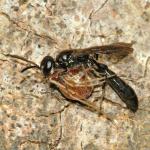Knowles (2009) provides guidance on the identification of this species within the T. figulus-group. It is likely to be well-represented in collections under T. figulus sens. lat. and there is a need to re-examine all old material.
In Britain this species is concentrated in the south-east of England, with scattered records westwards to Cornwall, south Wales and across to the south Midlands and East Anglia. There is an isolated record from eastern Scotland. Not known from Ireland or the Channel Islands.
Dollfuss (1991) states that it is known from the central and western Palaearctic, with the exception of north Africa. The Natural History Museum (London) collection includes specimens from Greece, Cyprus, Palestine, Israel and Turkey.
This species is not regarded as being scarce or threatened.
Records from Essex and Suffolk include coastal grazing marsh (where old fence posts may well be the main nesting habitat), abandoned sand and gravel pits where scrub is present, a golf course and Breckland grassland. It is therefore likely to occur in a wide variety of places where suitable nesting sites are present in warm, open areas.
Material in the Natural History Museum (London) covers the period early May to late August, with most specimens taken in June and July.
In keeping with the genus as a whole, small spiders are likely to form the larval diet.
Trypoxylon medium is a stem-nesting species (possibly also beetle burrows in dead wood).
No data available.
No data available.
2019


